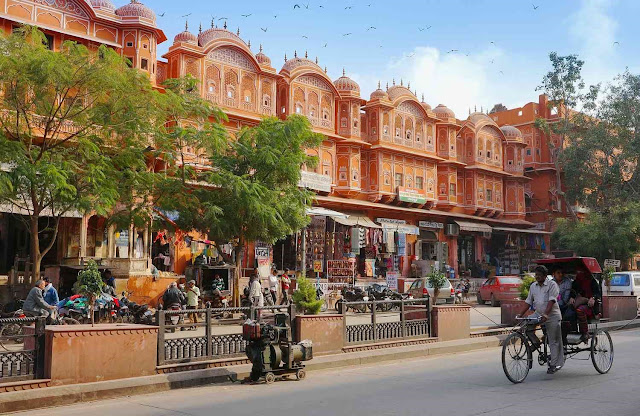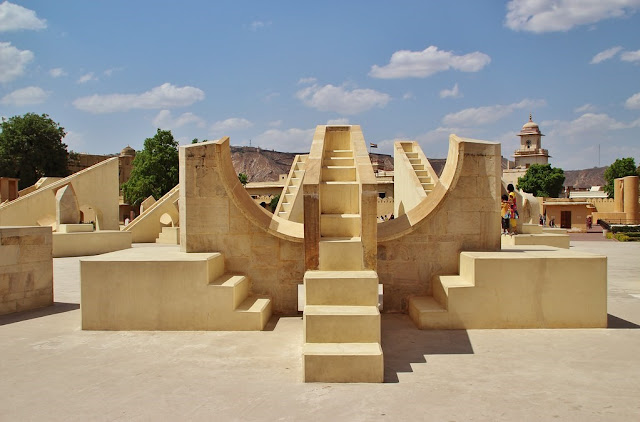Offbeat and Unique Things to Do in Jaipur
Offbeat and Unique Things to Do in
Jaipur
Jaipur, the
desert capital of Rajasthan and the "Pink City," is a UNESCO World
Heritage Site and part of the popular Golden Triangle tourist circuit (along
with Delhi and Agra). Top attractions in the city are the well-preserved
palaces and forts, which have elaborate architecture reflecting their royal
heritage. However, the addition of many cool shops, bars, cafes, and creative
spaces in recent years has made the city quite hip as well. Continue reading to
learn about the best things to do in Jaipur.
Apart from
visiting famous places such as Jantar Mantar, Amer Fort, Hawa Mahal, and
various areas of Jaipur that have endless stories, you should also visit the
offbeat places in Jaipur to get a true flavour of the city. Every corner of the
city has a story to tell, and one cannot forget how amazing and beautiful
Jaipur truly is. Jaipur is well-known for destination weddings, which are
especially designed for loved ones who visit every winter and create a lifetime
of memories.
Suggested
Tours: Jaipur Sightseeing Tour, Jaipur Tour, Jaipur Pushkar Tour, Jaipur Ranthambore Tour, 2 Days Jaipur Tour
Take part
in an Old City Heritage Walk.
Explore Jaipur's Old City beyond its famous monuments on one of the immersive heritage walking tours offered in the early morning or evening. Depending on the tour, you'll get to see artisan communities like bangle makers and metal workers, gemstone workshops, ancient temples, a traditional Ayurvedic hospital, and old stables converted into a market. The tours leave at 9 a.m. and 4 p.m. and last approximately two and a half hours. Another option is Virasat Experiences' informative Temples and Havelis Walking Tour. It reveals some of the Old City's lesser-known architectural wonders and local community traditions.
Go Behind
the Scenes of the Iconic Wind Palace
The
intricate facade of the Hawa Mahal (Wind Palace) is possibly Jaipur's most
photographed structure. It was built in 1799 by Maharaja Sawai Pratap Singh as
an extension of the City Palace's women's quarters to allow the royal women to
look out over the main street below without being noticed. The palace got its
name from the wind that blew through the shutters. However, most of them are
now sealed shut to help preserve them. It is possible to enter the Hawa Mahal
from the back entrance. Rajasthan's Department of Archaeology & Museums
sells government composite tickets for 300 rupees for Indians and 1,000 rupees
for foreigners.
Learn
About Astronomy
The
intriguing structures of Jantar Mantar are actually astrological instruments.
Each performs a specific astronomical function, such as time measurement,
eclipse prediction, and star tracking. The largest is the massive Samrat Yantra
sundial. Its shadow moves the width of a person's hand every minute from a
height of 90 feet (27 metres). It's a powerful demonstration of how quickly
time passes! The UNESCO World Heritage Site Jantar Mantar (literally
"calculation instrument") is one of five such astronomical
observatories built by Maharaja Sawai Jai Singh II, a renowned mathematician and
astronomer. It was finished in 1738 and is located in the Old City, next to the
City Palace.
Explore
the Amber Fort and Palace.
Amber Fort, which looks like something out of a fairy tale, sits on a hill overlooking Maota Lake about 30 minutes north of the city centre. In 1592, Maharaja Man Singh I, who led Mughal Emperor Akbar's army, began construction on the fort. It was the residence of Kachwaha Rajput rulers until 1727, when Maharaja Sawai Jai Singh II relocated their capital to Jaipur city. Inside are opulent palaces, halls, gardens, and temples. The elaborate mirror work adds to the opulence. Amber Fort is open from 8 a.m. to 5.30 p.m. daily. Many people choose to stay for the evening sound and light show that brings the fort's history to life, night viewing, and dinner. The fort reopens, those without a government composite ticket must pay 100 rupees for Indians and 500 rupees for foreigners.
View the
World's Largest Wheeled Cannon
In 1726,
Maharaja Sawai Jai Singh II built Jaigarh Fort to protect Amber Fort. This fort
is popular among military enthusiasts because it houses the world's largest
cannon on wheels. However, the cannon has never been fired, and the fort has
never been captured. As a result, it has remained remarkably intact throughout
its long life. In fact, the fort is one of mediaeval India's best-preserved
military structures. Jaigarh lacks the delicate palace interiors of Amber Fort
and thus appears to be a true fortress. Climb the Diwa Burj watchtower for a
spectacular view of the plains. Those who do not have a City Palace composite
ticket must pay a 50 rupee entry fee for Indians and a 100 rupee entry fee for
foreigners.
Spend
Sunset at Nahargarh Fort
The Nahargarh
Fort (also known as Tiger Fort) is perched high on the rugged Aravali Hills
northwest of Jaipur. It was commissioned in 1734 by Sawai Jai Singh II to help
strengthen the security of his new capital. It rose to prominence in 2006, when
scenes from the hit Bollywood film Rang De Basanti were shot there. The fort
offers breathtaking views of the city, especially at sunset. The Madhavendra
Bhavan palace complex, which serves as the backdrop for the new Sculpture Park,
is the highlight on the inside. If you do not have a government composite
ticket, you must pay an entry fee of 50 rupees for Indians and 200 rupees for
foreigners to enter the fort's palace.
Admire
the Remarkable Water Palace
The remarkable Jal Mahal (Water Palace) in Jaipur appears to float on Man Sagar Lake near Amber Fort. Little is known about its history, but it is believed that Maharaja Sawai Madho Singh I used it as a lodge for royal duck hunting trips in the mid-18th century. The palace actually has four submerged floors with specially designed lime mortar to prevent water seepage. Unfortunately, despite being renovated, the palace is still not open to the public, so you'll have to make do with viewing it from the side of the lake.
Relax at
the Royal Cenotaphs
Despite
being included in the City Palace composite ticket, most tourists miss the
Gatore ki Chhatriyan cenotaphs at the foothills of Nahargarh Fort. Most of the
time, this makes them delightfully restful. The exquisitely carved cenotaphs
honour Jaipur's late kings, ranging from Sawai Jai Singh ll to Man Singh ll.
The most impressive cenotaph honours Maharaja Sawai Jai Singh ll. It is made of
white marble, has 20 pillars, and is carved with Hindu gods and people. To get
there, take the Jaipur-Amber Road and exit near the Jal Mahal. Those without a
City Palace composite ticket must pay an entry fee of 40 rupees for Indians and
100 rupees for foreigners. The nearby Garh Ganesh temple is well worth a visit.
Get Up Close
to Monkeys
The somewhat
derelict but holy Galtaji temple is nestled between two granite cliffs on the
city's far eastern outskirts. It is part of a larger temple complex that also
includes three sacred water pools. Thousands of monkeys have taken over one of
the pools, congregating there to swim and bathe. They are generally friendly
and enjoy being fed. Unfortunately, the area is not well-kept. Prepare to come
across dirt and trash, as well as people who will try to force you to pay
money. Visit in the late afternoon, near sunset, when the monkeys congregate at
the temple. To get there, walk up the hill from the road to the white Sun
Temple, then downhill into the gorge.
Shop 'Til
You Drop
The city is
a great place to shop thanks to Maharaja Sawai Jai Singh II, who turned Jaipur
into a commercial hub by inviting artisans and traders to settle there.
Precious gemstones, silver jewellery, bangles, clothes, perfumes, blue pottery,
and textiles are among the items available. Each lane in the bazaars of the Old
City is dedicated to a different type of handicraft. Head to the crowded
Maniharon ka Rasta in Tripolia Bazaar for lacquer bangles (Awaz Mohammed is an
award-winning bangle-maker). Johari Bazaar sells inexpensive jewellery, while
Bapu Bazaar sells textiles. Thateron ka Rasta is home to metalworkers,
Jhalaniyon Ka Rasta is home to spice sellers, and Khajanewalon Ka Rasta is home
to marble statues. M.I. Road is lined with high-end branded shops.
.jpg)










Comments
Post a Comment